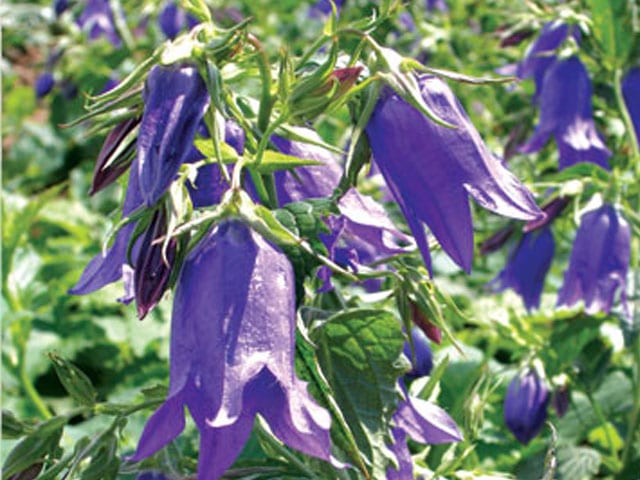Oh, I’ve been plant shopping. This wasn’t a major planned expedition; that happens later this month in the Niagara region. But I’ve been making some quick visits to garden centres along the way to other events, and I’ve found more of some favourites to add to those I already have. One is spotted bellflower (Campanula punctata ‘Kent Bells’, 18 x 24 in / 45 x 60 cm, Zone 4), which has been in the front garden for several years. It also makes a beautiful cut flower.

The bellflowers are a prolific and varied group, usually characterized by dangling, bell-shaped flowers. The descriptive term punctata (meaning pricked or dotted) refers to spots inside the flower’s bell tube that can only be seen by turning one up and peering inside. (Sometimes, on cool summer mornings, I find a sleeping bee in there.)
‘Kent Bells’ has hanging clusters of large, deep violet-blue bells above clumps of fresh green foliage, and grows in part shade to full sun. The plant spreads by underground rhizomes and is known to become invasive, but so far that hasn’t happened in my garden. I have it in too much shade, and that’s possibly the reason it remains politely in place.
I was pleased to find a pot of ‘Cherry Bells’ with deep rose-pink bells, reputedly larger than the blue flowers on ‘Kent Bells’. Now I’m looking for ‘Wedding Bells’, with intriguing hose-in-hose flowers, assembled with one flower inside another, as seen in some primula species. The flowers are white, with deep raspberry spots inside the bells. I don’t know what a bee would make of this double tube arrangement. Although there is the possibility of spreading rhizomes, I can’t feel worried about that. After all, this is a beautiful plant! If there’s too much of it, I’ll just pot up some divisions and share them around.
I also came upon some lovely ‘Obsidian’ coral bells (Heuchera ‘Obsidian’, Zone 5), with shiny purple-black foliage that will make an exciting contrast with early gold daylilies (already in bud) and variegated green and white ‘Patriot’ hostas. More excitement is always welcome, and I bought two of the dark coral bells.
There are several dark-leaved coral bells around, but often their foliage seems drab and fails to complement companion plants. ‘Obsidian’ leaves have a definite shine, like sequins in the flowerbed. And sequins are some of my favourite things!
Other posts by Judith this week:
Posts by Judith last week:









Such nostalgia…
I, too, have fallen for campanulas. Unfortunately, mine do spread themselves quite quickly here. I came up with a potential solution that has worked for over a year now. I purchased that cheap wavy plastic edging you can find in most garden sections of hardware stores. After edging my campanula patches into the desired size and shape, I simply installed this edging, leaving it a bit higher than soil level and find the dark mulch I use disguises it nicely. If you like unusual punctatas, you really should look for ‘Octopus’. It is a spectacular paler pink punctata whose petals are in strips very much like small pink octopuses hanging on the flower stems…delightful!
Hi Karen (May 10),
Thank you for two pieces of valuable information! What a clever technique, to encircle the Campanula punctata with plastic edging and then conceal it with mulch. You’ve invented a new product! I’m just beginning to know the various cultivars of C. punctata, and they are really charming. I might get a list together, and then look for sources. More gardeners need to know these lovely flowers.
— Judith